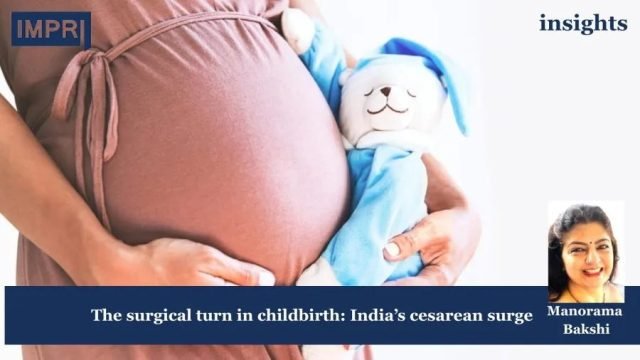Manorama Bakshi
Cesarean delivery, when required for medical reasons, is crucial in protecting the health of both mother and baby. But the sharp increase in planned C-sections, those chosen without urgent medical need, is subtly transforming how childbirth happens in India. I know this not just through data, but through personal experience. Both my children were born via cesarean section. The first time, my doctor calmly told me I had “excess amniotic fluid” and that natural labour might be risky. I was new to pregnancy, naïve and vulnerable, and I trusted the hands that held the stethoscope.
By the second time, I was a bit older, wiser, and had lived through birth once. I wanted to give labour a chance, to wait for the natural process. But when I told my doctor this, he simply said, “Since your first delivery was a C-section, it’s better not to take a chance, let’s just repeat it.” Then he added, “I’m travelling tomorrow. If we wait for labor, I won’t be available.” And just like that, I was wheeled into surgery once again. For a long time, I believed this was just my story, but it turns out, it’s not just personal.
It’s India’s story, and increasingly, a global one too. The National Family Health Survey-5 (NFHS-5, 2019–21) reports an overall cesarean rate of 21.5 per cent, up from 17.2 per cent in NFHS-4 (2015–16). 28 of 36 states and union territories now exceed the WHO’s recommended threshold of 10–15 per cent. Only Nagaland (5.2 per cent), Meghalaya (8 per cent), and Bihar (9.7 per cent) remain within limits. In Kerala, over 70 per cent of institutional births occur in private facilities, where elective cesareans dominate.
Urban, educated, and wealthier women disproportionately use these services, leading to higher rates of planned, non-indicated C-sections. NFHS data Public vs Private Sector Divide NFHS-5 data shows that 47.4 per cent of births in private hospitals are via C-section, compared to just 14.3 per cent in public facilities. Multivariate analysis reveals that delivering in a private facility increases the odds of a C-section nearly fourfold.
Socio-demographic Factors
Older maternal age, urban residence, higher education, and broader antenatal care all correlate with higher C-section rates. In Bihar’s wealthiest quintile, the odds of cesarean birth are nearly 13 times higher than in the poorest. Tamil Nadu shows a similar pattern with a nearly 3-fold difference.
Planned C-sections: A Trend of Convenience
In affluent states and private hospitals, a large share of cesareans are scheduled before labour — often for reasons unrelated to clinical need. In Kerala, around 70–73 per cent of low-risk cesareans happen electively. A German cohort study linked such pre-labour C-sections to a 21 per cent higher risk of acute lymphoblastic leukaemia and 29 per cent greater risk for certain subtypes, along with elevated asthma, type 1 diabetes, and allergy rates?
The Butterfly and the Cocoon: A Metaphor We Must Reclaim
There’s a parable I often return to: a man, seeing a butterfly struggle to emerge, cuts open the cocoon. The butterfly emerges — but weak, flightless. The struggle matters — it triggers strength and readiness. Labour, too, is not just pain; it is a biological and emotional preparation for both mother and child. Vaginal Birth, C-section, and Vaginal Seeding Babies born vaginally emerge bathed in maternal microbes — especially Lactobacillus and Bacteroides — which help train their immune systems to distinguish friend from foe.
C-section babies miss this microbial exposure. Research led by Dr. Maria Dominguez — Bello of NYU Langone, published in Nature Medicine, shows that “vaginal seeding” — swabbing C-section newborns with maternal vaginal fluids — can partially restore this microbial foundation. In a randomised controlled trial, seeded infants showed microbiota shifts closer to those of vaginally born babies. However, more extensive studies are needed, and the practice remains controversial due to infection risks. The American College of Obstetricians and Gynaecologists does not recommend it outside of clinical trials. Cesarean surgery is life-saving when indicated: for breech presentation, fetal distress, placenta previa, and other complications. But antenatal counselling should clearly distinguish medical necessity from elective preference.
Transparent discussion of medical indications· Clear communication of risks and benefits· Consideration of VBAC (vaginal birth after cesarean) and midwife-led care.
The Government of India, WHO, and UNICEF advocate: a) Institutional tracking of C-section rates· Promotion of midwife-led care for low-risk pregnancies, b) Strengthening public health systems for respectful, woman-centred maternity care
However, implementation remains uneven. Many private institutions continue to schedule surgeries not because they are needed, but because they are efficient, predictable, and profitable. C-sections are not the enemy. They are a vital part of modern obstetrics. The concern lies in the growing normalisation of planned, non-medical C-sections, particularly in better-resourced states and private hospitals.
These surgeries bypass not just pain but physiology — denying the newborn a foundational exposure to microbes, hormones, and emotional imprinting. We must return to evidence-based, respectful birth practices. We must honour labour not as a burden but as a blueprint. Because when we wait — with patience, with presence, and with trust — we give wings not only to babies, but to the women who bring them forth.
Manorama Bakshi is the Director & Head of Healthcare & Advocacy at Consocia Advisory, Founder of the Triloki Raj Foundation, senior visiting Fellow at IMPRI.
The article was published in THE PIONEER as Motherhood on the table and India’s rising cesarean surge on 31st July 2025.
Disclaimer: All views expressed in the article belong to the author and not necessarily to the organisation.
Read more at IMPRI:
The Tariff Pivot:Forcing India’s Hand from Commodity Exports to Value-Creation
Beyond Tariffs:How the US-India Trade War Reshapes Global Alliances
Acknowledgement: This article was posted by Srishti, a research intern at IMPRI.



















